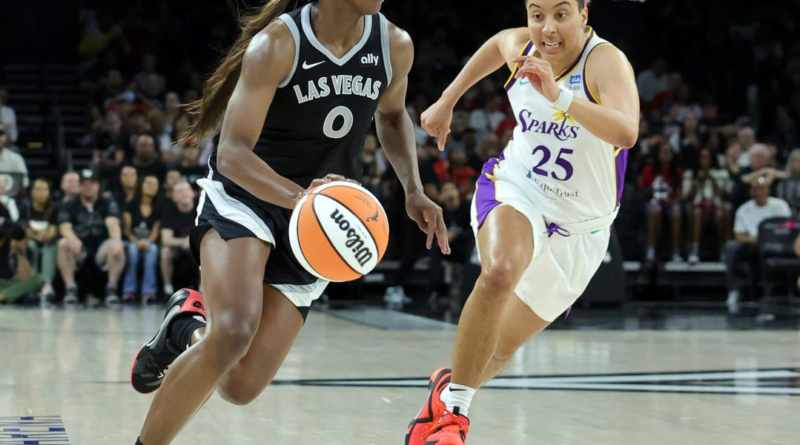The WNBA may block an effective 100% raise for its Las Vegas franchise’s players even as the sport reels from a huge gender pay gap
Players for the WNBA’s Las Vegas Aces each received a $100,000 sponsorship deal from the city’s tourism board.
One day later, the WNBA opened an investigation into the payments.
The deal would effectively double the pay of most players on the Aces—and more, in some cases. There are currently eight players on the Aces who make less than $100,000, according to Spotrac, a website that tracks the salaries of professional athletes. This comes at a time when the WNBA is under scrutiny for the emergence of the Caitlin Clark phenomenon, huge NCAA ratings for the women’s college game, and the huge pay disparities between WNBA players and their male counterparts, who on average make 85 times more. In the WNBA, the average base salary is $113,295, compared to $9.7 million in the NBA.
The investigation will likely try to determine whether the unusual arrangement, in which a sponsor signed individual deals with each player of the team, violates league rules on circumventing the salary cap. It is possible the league could deem the agreement, which the Aces organization said it was not involved with, as an effort to pay the team’s players supplemental income that other organizations might not be able to match.
A spokesperson for the Las Vegas Aces told Fortune to ask the WNBA why the team was being investigated. Meanwhile, the LVCVA said its offers were made through each player’s agent “in accordance with the rules of any sponsorship these athletes might accept, and consistent with our own long-standing sponsorship programs.” The WNBA did not respond to a request for comment.
If the league were to block the deal between the Aces and the LVCVA, it would amount to a major pay cut for many players who would have welcomed the sponsorship money.
“Definitely more than my salary,” Aces rookie Kate Martin, whose salary is $67,249, told ESPN. “I’m super thankful… I wouldn’t be getting this crazy bonus if it weren’t for how great all of these players have played in the last few years.”
Much of the investigation will likely hinge on whether certain players, most likely those with smaller roles on the team, were paid their “fair market value.” The collective bargaining agreement between the WNBA and the players union stipulates that a deal, which is “substantially in excess of the fair market value of any services to be rendered by the player” is not allowed.
The fact that all the Aces players will be paid the same amount—$100,000—could draw scrutiny from the league on those grounds. For example, the fact that Aces star player and two-time MVP A’ja Wilson will be paid the same by the Vegas tourism board as bench players who average less than two points a game could be perceived as an inflation of the latter’s “fair market value.”
Even for the highest-paid players on the Aces roster, who include Jackie Young, the highest-paid player in the WNBA, the LVCVA’s payment would amount to a significant portion of their base salaries. Young earns $252,450 a season, meaning she would get a 40% bonus. The other top earners on the Aces, Wilson and Kelsey Plum, each make $200,000 a year. For them the LVCVA’s sponsorship pay would amount to half their base salary.
Those salaries are a fraction of those earned by the highest-paid NBA players. Stephen Curry, the highest-paid player in the NBA, made $51.9 million last season—more than 200 times what Young earned. Even endorsement deals have major pay differentials. Sharpshooting phenom Caitlin Clark is set to land one of the biggest endorsement deals with an expected $28 million from Nike, while major NBA players like Curry often sign nine-figure deals complete with stock options and revenue or profit splits on shoe sales. A select few male athletes such as LeBron James and Michael Jordan have even reportedly been offered lifetime contracts from Nike.
LVCVA president and CEO Steve Hill seemed to have those pay disparities on his mind when he told Aces players about the unprecedented deal in the locker room on Friday. “Today we want to do something that is new, something that I don’t think anyone has done before,” Hill told the team. “We want to recognize you individually; we want to put some money in your pockets.”
Teams are not allowed to facilitate individual sponsorships for their players—meaning they must all be negotiated individually between a player’s agents and the company or brand that wishes to sponsor them. The deal was done the “the right way,” Hill told the Las Vegas Review-Journal.
The language in the collective bargaining agreement between the WNBA and the players’ union regarding exactly what kind of sponsorship deal is allowed and which isn’t is somewhat nebulous. Players are prohibited from accepting sponsorship money for “basketball services” even if the agreement is “ostensibly designated as being for non-basketball services.” This clause is meant to stop teams from disguising third-party payments from purported sponsors as supplemental pay that would give them an unfair financial advantage.
Hill added that he was open to providing the league with more details. “We’re happy to answer any questions they have,” he said.
This is the third time the Aces have been investigated in the last year and a half. In February 2023, the team was investigated for allegedly circumventing the WNBA’s salary cap rules for offering under-the-table payments to players. Later that year an investigation into inappropriate comments by head coach Becky Hammon to former player Dearica Hamby over her pregnancy resulted in a two-game suspension.
Update May 20, 2024: This article has been updated to include a statement from the Las Vegas Convention and Visitors Authority.



